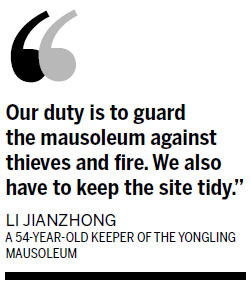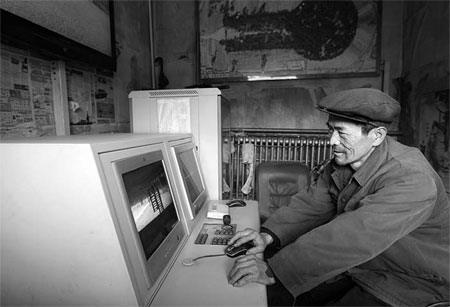
 'Taken 2' grabs movie box office crown
'Taken 2' grabs movie box office crown
 Rihanna's 'Diamonds' tops UK pop chart
Rihanna's 'Diamonds' tops UK pop chart
 Fans get look at vintage Rolling Stones
Fans get look at vintage Rolling Stones
 Celebrities attend Power of Women event
Celebrities attend Power of Women event
 Ang Lee breaks 'every rule' to make unlikely new Life of Pi film
Ang Lee breaks 'every rule' to make unlikely new Life of Pi film
 Rihanna almost thrown out of nightclub
Rihanna almost thrown out of nightclub
 'Dark Knight' wins weekend box office
'Dark Knight' wins weekend box office
 'Total Recall' stars gather in Beverly Hills
'Total Recall' stars gather in Beverly Hills
Guarding the legacy of emperors
Updated: 2013-04-04 08:09
By Wang Xiaodong (China Daily)
|
|||||||||
|
Liu Yanliang, a keeper of the Kangling Mausoleum, one of the tombs of the Royal Mausoleum of Ming, patrols the grounds last month. Photos by Cui Meng / China Daily |
|
Qi Zhenxiang, a keeper of the Yongling mausoleums, can watch the site on a computer. |

A dedicated few in Beijing's suburbs keep a lookout for tomb raiders, day and night
It was a clear day in March, and the air was still cold on this morning of early spring in Beijing.
Li Jianzhong, a 54-year-old keeper of the Yongling Mausoleum, was walking along a path as usual, checking to see if there was any problem or threat in the mausoleum.
The mausoleum, in which Emperor Jiajing of the Ming Dynasty (1368-1644) and his three empresses were buried, was empty, except for several researchers - college students guided by their archeology professor. Like most of other tombs of the Royal Mausoleum of Ming, Yongling Mausoleum is not open to the public.
For the past three years, Li has been guarding the tomb with his two colleagues recruited by the Ming Tombs Special Administration. They work in shifts to ensure the tomb is monitored 24 hours a day.
On a regular day, he would spend about half an hour patrolling around the mausoleum, and make seven or eight trips every day.
"Our duty is to guard the mausoleum against thieves and fire," Li said. "We also have to keep the site tidy."
Li has not encountered any thieves, thanks to strict protection measures of the Ming Tombs Special Administration. But fire is a more dangerous hazard. Any fire is forbidden, he said.
"No one is allowed to smoke in the mausoleum," he added.
More measures to guard against fire are taken from October until May, as the weather is dry during this time around Beijing, he said.
"We usually start to cut off grass at the mausoleum and nearby at the end of September, as it can catch fire easily," he said.
To remove the grass, usually as high as one meter and growing amid the gaps of bricks and stones, is never easy. It often takes days to finish the work, he said.
"This is the most tiring part for us," he said, noting that in general, the work is not very hard.
"But sometimes it is a little lonely, feeling cut off from the outside world."
Modern technology has also made the work of the keepers much easier.
A complete anti-theft system has been installed in the Royal Mausoleum of Ming, the 80-square-kilometer cemetery of the 13 emperors of the Ming Dynasty and a World Heritage site, according to the Ming Tombs Special Administration in Beijing. Other equipment that has been widely adopted at the site - located 50 km outside Beijing - such as cameras, has also greatly reduced the burden of tomb keepers like Li.
In Yongling Mausoleum alone, 11 cameras have been installed since 2006, at every corner and covering the entire area, according to Li.
"Besides checking on site, we can also check the entire mausoleum at our computer screen at the office, so on rainy days we don't have to go out to check so often," Li said.
The simple office for Li's team sits near the gate of the mausoleum and is less than 10 square meters. Inside, three large screens linked to the cameras give a real-time display of key areas, including the interiors of some buildings.
Qi Zhenxiang, a colleague of Li, was on duty sitting in front of a screen.
A single bed lies on the other side of the room, making it a temporary dorm.
"We usually work here and go back to our village to have meal," Li said.
Both Li and Qi live in Yongling village, one named after the mausoleum, which is only 10 minutes' walk away.
"My ancestors came to the village several hundreds years ago during the Qing Dynasty (1644-1911) as tomb keepers," Li said. "I don't know which generation I am."
Like Yongling Mausoleum, every mausoleum of the Royal Mausoleum of Ming is located near a village named after the mausoleum.
According to Hu Hansheng, a researcher in Ming tomb study in the special administration, most of the villagers near the tombs are descendants of keepers assigned during the Qing Dynasty.
Although each village in the area now has hundreds of residents, only a few keepers are needed for each mausoleum, Hu said.
"Most of the villagers are doing other business, often migrating to cities to work, and only these few villagers continue to do the work their ancestors did," he said.
Keepers in the old times were assigned primarily to guard against tomb thieves, as precious treasures were buried under the imperial tombs, Hu said.
"The main purpose of the keepers today is preserving the cultural legacy," he said.
Besides these keepers, armed police forces are also deployed in Changling and Dingling mausoleums, as cultural relics obtained from the tombs have been displayed there, he said.
Liu Yanliang, a tomb keeper of Kangling Mausoleum, said protection of the sites has been intensified, compared to 10 years ago when he started to work there.
"It is much more difficult to access the mausoleum these days, unless you have a special permit from the Ming Tombs Special Administration," he said.
"Only old guys like us are willing to do the job," Liu said. "The young ones could not stay here for long, as they like places with more people."
To avoid loneliness, Liu raised a dog, named "Dahei", meaning big black guy.
"Though Dahei is obedient and cute, I am not satisfied with him," he said.
"I tried to train him like a bodyguard so he could stop bad guys from entering the mausoleum, but I failed. Now he seems to welcome every visitor," he said, laughing.
Although one of his legs was injured in a car accident a few years ago, Liu still keeps walking and checking the whole mausoleum several times every day.
"Everyone knows these royal tombs are a valuable cultural legacy of mankind," he said. "It is our duty to keep them intact.
wangxiaodong@chinadaily.com.cn
(China Daily 04/04/2013 page5)
Most Viewed
Editor's Picks

|

|

|

|

|

|
Today's Top News
Boston bombing suspect reported cornered on boat
7.0-magnitude quake hits Sichuan
Cross-talk artist helps to spread the word
'Green' awareness levels drop in Beijing
Palace Museum spruces up
First couple on Time's list of most influential
H7N9 flu transmission studied
Trading channels 'need to broaden'
US Weekly

|

|










